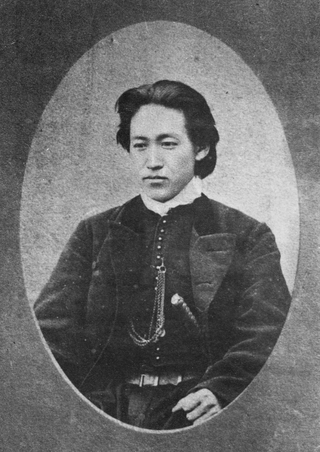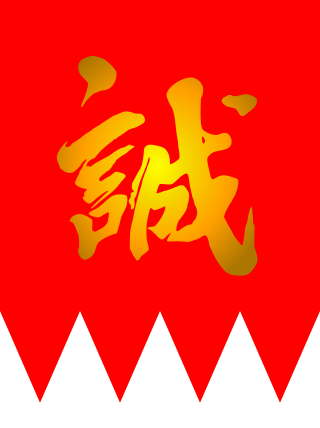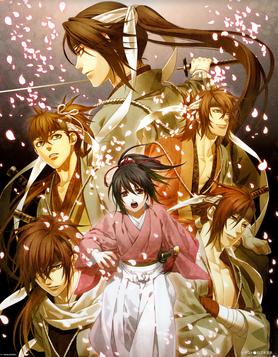
Kido Takayoshi, formerly known as Katsura Kogorō, was a Japanese statesman, samurai and shishi who is considered one of the three great nobles who led the Meiji Restoration.

Kondō Isami was a Japanese swordsman and samurai of the late Edo period. He was the fourth generation master of Tennen Rishin-ryū and was famed for his role as commander of the Shinsengumi.

Hijikata Toshizō was a Japanese warrior. As Vice-Commander of the Shinsengumi, he resisted the Meiji Restoration and fought to his end.

The Shinsengumi was a small, elite group of swordsmen that was organized by commoners and low rank samurai, commissioned by the bakufu during Japan's Bakumatsu period in 1863. It was active until 1869. It was founded to protect the shogunate representatives in Kyoto at a time when a controversial imperial edict to exclude foreign trade from Japan had been made and the Chōshū clan had been forced from the imperial court. They gained considerable fame in the Ikedaya incident and the August 18 coup events, among others. The men were drawn from the sword schools of Edo.

Okita Sōji was the captain of the first unit of the Shinsengumi, a special police force in Kyoto during the late shogunate period. He was one of the best swordsmen of the Shinsengumi.

Saitō Hajime was a Japanese samurai of the late Edo period, who most famously served as the captain of the third unit of the Shinsengumi. He was one of the few core members who survived the numerous wars of the Bakumatsu period. He was later known as Fujita Gorō and worked as a police officer in Tokyo during the Meiji Restoration where he worked mostly undercover for them along with the Japanese government.

Nagakura Shinpachi was the captain of the 2nd troop of the Shinsengumi, He was later known as Sugimura Yoshie during the Meiji era.
Yamanami Keisuke was a Japanese samurai. He was the General Secretary of the Shinsengumi, a special police force in Kyoto during the late Edo period.

The Ikedaya incident, also known as the Ikedaya affair or Ikedaya riot, was an armed encounter between the shishi which included masterless samurai (rōnin) formally employed by the Chōshū, Tosa and Higo domains (han), and the Shinsengumi, the Bakufu's special police force in Kyoto on July 8, 1864, at the Ikedaya Inn in Sanjō-Kawaramachi, Kyoto, Japan.
Harada Sanosuke was a Japanese warrior (samurai) who lived in the late Edo period. He was the 10th unit captain of the Shinsengumi, and died during the Boshin War.
Ichimura Tetsunosuke was a Japanese member of the Shinsengumi and Hijikata Toshizō's page. Although commonly believed to be a fictional character, Ichimura Tetsunosuke was a real member of the Shinsengumi.
Inoue Genzaburō was born in Hino, Tokyo. He was the captain of the sixth unit of the Shinsengumi which were a special police force for the Tokugawa regime. Inoue was the oldest unit captain of the Shinsengumi.

The Battle of Kōshū-Katsunuma took place between pro-Imperial and Tokugawa shogunate forces during the Boshin War in Japan. The battle followed the Battle of Toba–Fushimi on 29 March 1868.
Tōdō Heisuke was a samurai of Japan's late Edo period who served as the eighth unit captain of the Shinsengumi. His full name was Tōdō Heisuke Fujiwara no Yoshitora.
The Edo period of the history of Japan is the setting of many works of popular culture. These include novels, stage plays, films, television shows, animated works, manga, and video games. Major events of the period, such as the Siege of Osaka, Shimabara Rebellion, and the decline and fall of the Tokugawa shogunate figure prominently in many works. Historical and fictional people and groups of the period, including Miyamoto Musashi, Izumo no Okuni, Yagyū Jūbei Mitsuyoshi, the fictional Isshin Tasuke, Yui Shōsetsu, Matsuo Bashō, Tokugawa Mitsukuni, Ōoka Tadasuke, Tōyama Kagemoto, the Forty-seven Ronin, Sakamoto Ryōma, Katsu Kaishū, and the Shinsengumi, as well as the fifteen Tokugawa shoguns were active for much or all of their public lives and are dramatized in works of popular culture. The cultural developments of the times, including kabuki, bunraku, and ukiyo-e, and practices like sankin kōtai and pilgrimages to the Ise Shrine, feature in many works set in Edo Japan.

Hakuoki is a Japanese otome video game series by Idea Factory, first released for the PlayStation 2 on the 18th September 2008 and ported to many other platforms. It has been adapted into an anime series by Studio Deen; the first series was broadcast from April to June 2010, and the second series was broadcast from October to December 2010. An OVA series, titled Hakuoki: A Memory of Snow Flowers and adapting from Hakuoki: Stories of Shinsengumi was released from August 2011 to July 2012. A third series based on the prequel, Hakuoki Reimeiroku was broadcast from July to September 2012. The series has also been adapted as two different manga series.

Ryū ga Gotoku Ishin! is an action-adventure video game developed by Ryu Ga Gotoku Studio and published by Sega for the PlayStation 3 and PlayStation 4. It is a spin-off of the Like a Dragon series, formerly and commonly known in English localization as Yakuza. It was released on February 22, 2014, exclusively in Japan, serving as a launch title for the PlayStation 4. A remake, Like a Dragon: Ishin!, was released in February 2023 for PlayStation 4, PlayStation 5, Windows, Xbox One, and Xbox Series X/S. It was developed using Unreal Engine 4, and received a worldwide release unlike the original game.
Hakuoki: Wild Dance of Kyoto, is a 2013 Japanese animated historical fantasy action film based on the otome game series Hakuoki by Otomate. The film is the first instalment of Hakuoki duology film directed by Osamu Yamasaki and produced by Studio Deen. The film serves as alternate retelling of the first season of the anime series Hakuoki: Demon of the Fleeting Blossom. Aika Yoshioka returns to provide the theme song of the film titled "Kurenai no Ito" (紅ノ絲, lit. Crimson Thread). A sequel, titled Hakuoki: Warrior Spirit of the Blue Sky, was released in 2014.
Hakuoki: Warrior Spirit of the Blue Sky, is a 2014 Japanese animated historical fantasy romance action film based on the otome game series Hakuoki by Otomate. The film is the sequel to Hakuoki: Wild Dance of Kyoto and the last instalment of Hakuoki film series. The film serves as alternate retelling of the second season of the anime series. Like the anime series and the previous film, Aika Yoshioka provides the theme song titled "Sōkyū no Hata".











